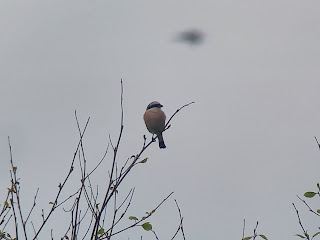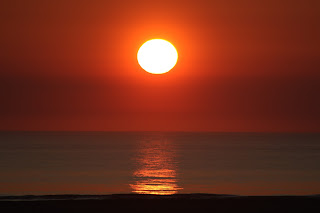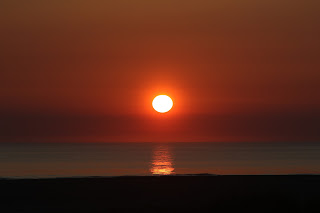After a two hour flight from Stanstead Airport and then a further two hour train journey, on Monday evening I arrived at Skagen Station, where the current apartment guests Søren and Karen Marie kindly picked me up and drove me the short rest of the way to Skagen Fuglestation (Skagen Bird Observatory), where I will be volunteering until 2nd July. Earlier in the day a singing Greenish Warbler had been found, but after a tiring journey and unpacking my things I decided against going for it. Instead I went to bed quite early (like everyone else does here) in preparation for getting up at 03:30 in the morning - yes we are all that crazy but on the good days it is most definitely worth it.
Yesterday morning I headed out with Dante to World's End (one of the observation/vismig points here). Cycling on route we heard at least 2 Marsh Warbler (my first of 7 lifers I managed throughout the day), plus lots of Whitethroat and a couple of Lesser Whitethroat, It did not take long for us to move off again though because there were just swarms of midges everywhere. Dante stated that this was the worst he has ever known here. We decided to walk round to the outer dunes where thankfully less midges were about. We had great views of a Great Northern Diver that cut across the land, shortly followed by another one a bit further out. 2 Black-throated Divers then cut across the land too. It was great for me to see both of these new species for me in such quick succession as it really allowed me to make a comparison on their structure and behaviour and I already feel confident identifying the main diver species even when they are a lot further away. 2 Hobby migrated north east, as well as several Sparrowhawk. The cloud cover and rain moving in from the south seemed to be keeping most birds relatively low and the lighting conditions made features of birds over the sea fairly easy to assess. However, with the birds over the land the lighting made it a bit more tricky. Through my binoculars I picked out my first ever Velvet Scoter flying over the sea and later I saw a flock of 8 flying about. 2 Red-breasted Merganser flew east and Dante picked up a pair of Garganey over the land just south of us. After a while of trying to tune out the mimicry of the Whitethroats (I am sure they don't do this back home) we managed to pick out a singing and calling Common Rosefinch. A flock of 80-100 thunbergi (Grey-headed) Yellow Wagtails regularly flew around and dropped in front of us. It was great to get such good views of this new subspecies for me and we also managed to pick out a few Blue-headed Wagtails too. Dante got onto an interesting individual which looked like it had a darker head than the other wagtails. However, the presence of a slight pale supercilium ruled out the possibility of a feldegg Black-headed Wagtail. But then we got onto another darker headed bird and this one did not have any hint of a supercilium. At certain angles it looked so much darker than the surrounding wagtails but in the end Dante decided that it probably had a bit too much grey showing on the nape for a feldegg. On our way back to the observatory to avoid the worst of the rain we attempted to have a quick stop and listen at Ellekrattet, Denmark's northernmost deciduous forest, but again the swarms of midges meant that we did not stop still for long at all. Back at the observatory I enjoyed watching a White Wagtail and I also had a quick snooze.
Once the rain had eased off again I headed back out towards the outer dunes. Instead of going into Ellekrattet I took a path that went to the side and up towards a house. From the view point here I had good views of Hawfinch, 2 Hooded Crow flying west and 2 Raven flying south. Despite seeing quite a few now, I still have not got used to the sight of Bitterns flying about. All the gulls went up and were noisy. A quick scan of the sky got me onto an Osprey heading south. Usually they just power through any conditions and continue migrating north so it was told it was unusual to see one going the other way in spring. Dante and Lauren then found a Red-breasted Flycatcher further south and most birders headed off to try and see it. I decided to continue north towards the outer dunes as I had intended to. Thankfully I was not made to regret my decision. I may not have seen the Red-breasted Flycatcher, but I did get to see 2 Black Guillemot fly east, a minimum of 5 Red-backed Shrikes and a migrating ringtail Hen Harrier that went over directly above my head. On route back to the observatory I heard a singing Icterine Warbler whilst watching a Spotted Flycatcher and a Rough-legged Buzzard flew low north before shortly returning south. My eBird lists from Tuesday morning and then the afternoon can be seen
here and
here.
.JPG) |
| Arctic Terns |
.JPG) |
| Bittern |
.JPG) |
| Hen Harrier |
.JPG) |
| Rough-legged Buzzard |
 |
| Male Red-backed Shrike |
 |
| Female Red-backed Shrike |
This morning I again headed to the outer dunes with Dante. The clear sky and minimal wind meant that it was a slower morning than yesterday. However, I was still very happy with what we got. Out to sea we had: 3 Shag west, 14 Red-throated Diver east and 9 west, 2 Black-throated Diver east and 2 west, 1 Black Guillemot east and 2 west, 1 Barnacle Goose east, 1 Arctic Skua, 6 Red-breasted Merganser, 3 Velvet Scoter, 2 adult Kittiwake, and 1 male Goldeneye. 6 Honey Buzzard migrated north, the regular pair of Common Cranes flew about, as did the rufous female Cuckoo and a couple of Hawfinch. I had a brief view of a Short-eared Owl. A decent number of Tree Pipits buzzed above our heads and there was some corvid activity with Carrion and Hooded Crows, Jackdaws, Magpies and Jays all attempting to migrate. Dante got me onto a distant Ring Ouzel and we also heard the Rosefinch again - I hope I actually see one at some point. Just I was leaving 5 Common Buzzard flew back south after attempting to migrate. I am now having a rest in the observatory and as I am writing this I can see a group of Eider from the kitchen window. Full eBird list from this morning
here.

Sunrise above and below
Adult female Honey Buzzard below:
.JPG) |
| This female appears to show a 6th 'finger' (longer p5) which is a feature of Crested Honey Buzzard, but no other feature seems to suggest any possibility of a hybrid. |
Adult male Honey Buzzards below:
 |
| Cuckoo |
.JPG)
.JPG)
.JPG)
.JPG)


.JPG)
.JPG)



.JPG)
.JPG)
.JPG)
No comments:
Post a Comment